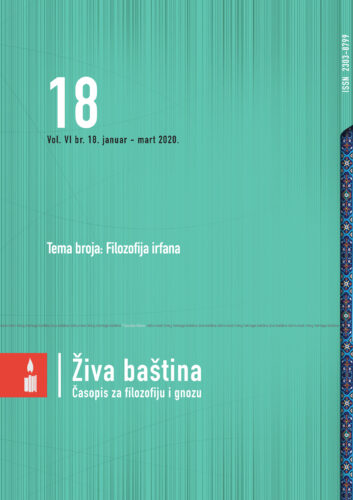Jedan od puteva spoznaje Uzvišenog Boga je duhovno otkrovenje i vizija. Ovaj rad nakon definiranja duhovnog otkrovenja
i vizije bavi se pitanjima razlike između otkrovenja i kerameta, rahmanijetskih i šejtanskih otkrovenja, te nužnosti postojanja mjerila ispravnosti duhovnih otkrovenja, a to su: razum, Božija Knjiga i tradicija.
U nastavku autor analizira mjerila vjerodostojnosti i istinitosti otkrovenja iz ugla kur’anskih ajeta i to ajeta koji govore
o susretu s Bogom, iskrenim robovima, duhovnom osvjedočenju, posmatranju carstva nebeskog i zemaljskog, furkanu, to
jest sposobnosti razlikovanja istine od neistine, te ajeta o džihadu i ajeta o pravječnom zavjetu.
Također, razmatraju se predaje koje nude mjerila vjerodostojnosti i istinitosti irfanskih otkrovenja, a to su: predaja o
iskrenosti, 4. 86. i 220. govor Staze rječitosti, predaja poznata kao Onvane Basri, predaja o božanskoj svjetlosti posredstvom koje vjernik gleda, Miradž Poslanika, s.a.v.a., predaja “nafile koje približavaju”, predaja “gledanje u Gospodara istinama vjerovanja”, predaja iz djela Tuhaful-‘uqūl, Šabansko šaputanje.
The Gnostic Revelation and Vision
Sayyed Ishāq Hoseynī Kūhsārī
Abstract
One of the paths of cognition of God the Exalted is a spiritual revelation and vision. This paper, after defining spiritual revelation and vision, discusses the difference between revelation and miracle, divine and satanic revelations, the necessity of having some criteria for correctness of spiritual revelations, and these are: the intellect, God’s Book and tradition.
Further, the author analyses the criteria for authenticity and veracity of revelations from the perspective of the Qur’anic verses, namely the verses that talk about meeting God, sincere servants, spiritual revelation, observing the Kingdom od Heavens and Earth, furqān, i.e. the ability to distinguish truth form falsehood, the verse about jihad and the verse about the Pre-eternal Covenant.
In addition, the traditions that offer the criteria for the authenticity and veracity of gnostic revelations have also been analyzed, and they are: the tradition about sincerity, the fourth, the seventy eighth and the two hundred and second sermon from the Path of Eloquence, the tradition known as ‘Unwān Basrī, the tradition about Divine Light by virtue of which the believer sees, the ascent of Prophet, s.a.w.a. to the Heavens, the tradition about “voluntary prayers which bring the believer closer to God”, the tradition about “watching God with the truths of believing”, the tradition from the book Tuhaful-‘uqūl, the supplication ‘Arafa, the Whispering of Shabān.
[tags]

